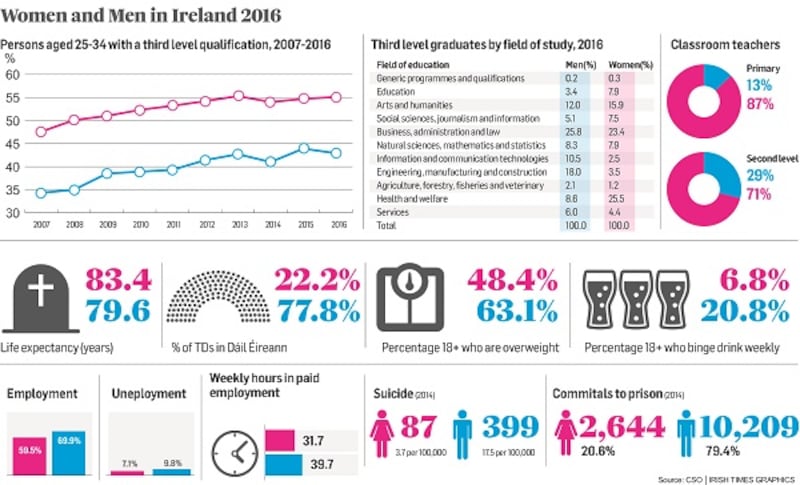On average, women are paid 14 per cent less than men, the latest data from the Central Statistics Office shows, indicating that pay differences are widening.
The figures from 2014 are based on gross hourly earnings, and compare with a 12 per cent difference between men and women’s pay in 2012.
So despite improvements in other areas of gender equality in Ireland, this gap has been growing.
At the same time, the CSO figures show that more than 55 per cent of all women aged 25-34 years had a third-level qualification in 2016, compared with 43 per cent of men in the same age group.
So women have made strides in education, but that is not translating into earning power.

The subjects men and women study at third level continue to be polarised. Male graduates dominate engineering, manufacturing, construction and information and communication technologies. Female graduates dominate health, welfare and education.
With educational differences such as that, it is no surprise that a third of women at work in Ireland in 2016 were employed in the health and education sectors, while the highest proportions of men were in construction, agriculture and transport.
The divergence seems to begin much earlier in the education system. By the time the class of 2016 sat down to their Leaving Cert, more girls were taking higher-level English, French, Irish, biology, chemistry, art, home economics and music, and more boys were taking higher level mathematics, physics, design and communication graphics, construction studies and engineering.
Working in the home
The difference between men and women working in the home is also stark.
In the 2016 census, 98 per cent of those who said they were looking after the home and/or family were women. And of the country’s 2.3 million men, 9,200 said they were looking after home or family. Although this has increased in the past 10 years, up from 4,900 in 2006, in terms of gender equality, it is hardly worth cheering about.
The housework divide was echoed in a recent report from the European Institute for Gender Equality, which found that women in Ireland are still doing 40 per cent more housework than men, whether working or not.
One question the data cannot answer is: does the gender pay gap exists because the work women undertake is less valued, or is the work less valued because women undertake it?
It also points to the need for early intervention in the education system to attract more girls into male-dominated subjects and vice versa.
As the OECD has said, gender equality is not just about economic empowerment, it is about fairness and equity. It is also a key factor in self-reported wellbeing and happiness across the world.









